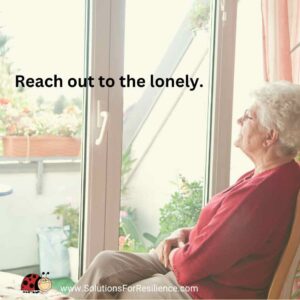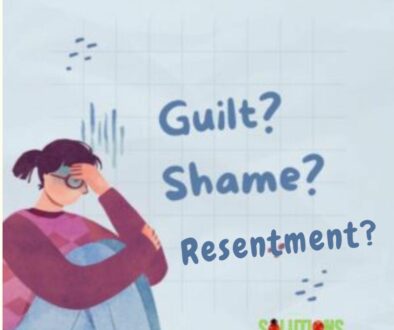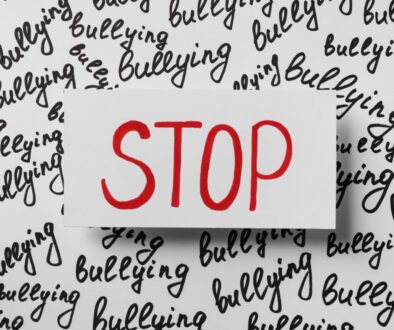Reach Out to those Feeling Lonely: Flatten the Curve
 Feeling Lonely?
Feeling Lonely?
Have you had some significant moments of feeling lonely? Most of us have felt deep and empty disconnect and sadness. I felt it as a farm girl, living at the end of a long lane. I felt it in high school, being surrounded by other students while feeling shunned. I felt it when I moved to the city and knew no one. But I definitely was not part of a loneliness curve that concerned the World Health Organization.
Many of us feel transient or temporary loneliness when we lose a loved one, lose a marriage or another intimate relationship ends, or we enter a new learning environment, job, or community, or we are merely shunned because we are, in some way, different. These are classic feeling lonely scenarios. However, loneliness is only an issue when it becomes part of one’s lifestyle, a resignation to forever being disconnected. It is important to acknowledge the difference between fleeting moments of loneliness and chronic loneliness.
Certainly COVID-19 has brought the issue of loneliness to the forefront. Because of the requirement to physically distance and more often stay home, it is difficult to make affirming connections. Indeed, it was in October 2020 the Angus Reid Institute, Canada’s non-profit foundation, committed to independent research, headlined a release stating: Isolation, Loneliness, and COVID-19: Pandemic leads to sharp increase in mental health challenges, social woes!
Before we explore these social woes I will define loneliness and three correlated words.
Lonely Definitions
Definitions will give us a mutual language and understanding. Even so, you will notice some cross-over in meanings.
Alone means no one else is present. Think about Me-Time; that desire many parents declare they need. They are rejuvenated by separating from the noise, demands and responsibilities of family life to relax on their own.
Isolated means to be far away from other people. Think about the classic 1719 novel, The Life and Adventures of Robinson Crusoe: a man alone for years and years on an island with little but palm trees, coconuts, and fish. Then there is Tom Hanks, staring in the year 2000 movie, Castaway. The main character names a basketball Wilson and develops an intense relationship with the object to alleviate his forlorn sense of loneliness. It may interest you to know that the word isolated comes from the Latin word insula, which means island.
Solitude means a state of seclusion or isolation and a lack of contact with people. Most often, solitude indicates that aloneness was chosen, not imposed. Short-term solitude may be chosen for the sake of privacy, contemplation, or a purposeful retreat. Poets and artists wax eloquent about the gifts of solitude. In years past, only the wealthy could afford the luxury of solitude.
Loneliness means an enduring condition of emotional distress that arises when a person feels estranged from, misunderstood, or rejected by others and lacks appropriate social partners for desired activities, particularly activities that provide a sense of social integration and opportunities for emotional intimacy.
This definition of loneliness comes from Dr. Lars Andersson, a University of Sweden, loneliness researcher.
And yet another definition from Dr. Stephanie Cacioppo of the University of Chicago:
“It is the discrepancy between what you have and what you want from your relationships.”
Basically, the feeling of loneliness is involuntary aloneness with a sense of lack of social connection. Chronic loneliness was a problem before COVID-19 and is ongoing. A 2018 Tweet from The Economist read, “Loneliness is the leprosy of the 21st-century.” From here on in, I will use the term, the lonely, to describe people experiencing chronic loneliness, which shows up in a myriad of ways.
Dr. Eric Klingenberg, the author of Going Solo: The Extraordinary Rise and Surprising Appeal of Living Alone wrote, “The occasional and transitory feeling of loneliness can be healthy and productive. It is a biological signal to ourselves that we need to build stronger social bonds.” Indeed, we need to get the lonely connected.
Loneliness Signals
Seldom do people identify with having a loneliness issue. Typically, they share a familiar problem or a more socially acceptable emotion.
Some people incorrectly conclude that, because someone is single, a single parent, widowed, elderly, identify as LGBTQ2 or is an immigrant, they feel lonely. The loneliness literature takes these factors into consideration but points out that perspective and connection, or lack of it, are the deciding factors. Loneliness more often shows its face in physical and mental health problems.
Loneliness Researcher, Julianne Holt-Lunstad, found that many of the lonely were excessive smokers, obese, and were dealing with mental health issues. It is like cigarettes, vapes, food, alcohol or drugs become best friends. In more specific terms Holt-Lunstad describes correlations with loneliness:
- Coronary heart disease
- High blood pressure
- Stroke
- Dementia
- Depression
- More immune dysfunction
- Anxiety
- Lower quality of sleep
- Excessive use of alcohol.
- Impaired judgement
- Impulsiveness
Obviously, for the lonely and those who care about them, loneliness needs to be addressed. Disregarding the feeling of loneliness can lead to adverse physical and mental health effects.
Connection is the antidote. My hubby likes a significant amount of alone time. After retiring he was getting ample solitude but also showing some memory issues. A geriatric specialist encouraged him to become more social. After joining Rotary and engaging in volunteering his bright memory returned. I cannot imagine him saying “I was lonely” but his lack of social engagement did affect him.
Ways to Connect with the Lonely
Holt-Lunstad wrote, “The mere perception of the availability of support can go a long way in helping not only our emotional well-being but our physical health.” This finding is encouraging. Just letting someone know you care makes a difference! We can reach out to anyone including friends, family, neighbours, or even strangers.
Dr. Vivek Murphy the past American, Surgeon General and author of Together, says, “The foundation for connecting with other people is connection to ourselves.” Before approaching another, ask yourself, “Am I feeling worthy and having nothing to prove?” and “Do I feel grounded, present and peaceful?” You are ready to approach if your answers are yes.
When we do reach out, Murphy cautions us to approach others for connection and not for personal validation. You want to avoid seeking acknowledgement for yourself but rather offer kindness from a full and present heart. Do not perceive nor treat the lonely as victims or less than. Approach them with curiosity, empathy, and a query of “How can I help?”
Second, we approach with empathy which requires us to seek to understand the other, to imagine what loneliness feels like, looks like, and sounds like. We have neurons in our brains that allow us to relate to, or imagine, someone else’s internal, personal, and emotional selves. Merely recall your own moments, days or weeks of loneliness.
16 Ways to Connect
- Affirm Their Reality. Remind them they are not alone; that you too have had moments of feeling lonely. Allow yourself to be vulnerable and share your own stories of loneliness.
- Check Feelings. When you sense the moment is right, ask, “Do you feel lonely?” It can provide relief to merely accept the reality of loneliness.
- Welcome In. Invite them to join one of your groups, clubs, classes, or community events. Even better, invite them to join you in a volunteer cause. Share helper’s high with them.
- Initiate. Invite them to go for a walk or for a cup of coffee.
- Use the Phone. Call them or, alternatively, make a Zoom or Facetime date. Begin by saying, “I was thinking of you.” We all benefit from being seen, heard, and acknowledged.
- Text and Email. Also consider writing an old-fashioned letter. Many people consider receiving a mailed letter, and I’m not referring to bills, as an honor and treat.
- Name them Friend. Start using the phrase, “my friend” as in “It was good chatting with you, my friend.”
- Create Emotional Safety. Be an emotionally supportive person.
- Show a kind heart, seldom speak ill of others, or judge them.
- Demonstrate patience and gentleness.
- Welcome the sharing of all feelings. Feelings are different than inappropriate words (name calling, put downs, criticism or swearing) or behaviors.
- Listen with acceptance, curiosity, and an eagerness to understand. Say, “Tell me more” often.
- Smile and Laugh. Smiling tells others we like something about them or what they are doing. Add “I like your creative ideas.” Laughing indicates experiencing joy with another.
- See Strengths. Notice and encourage their gifts and strengths as in “Thank you for showing such deep honesty.”
- Touch. When COVID-19 no longer exists, frequently, generously, and enthusiastically hug.
- Fill a Role. Consider accepting the role of mentor or even adopted sister, brother, uncle, parent, or grandparent. Many groups that sponsor immigrants provide these unmet roles.
- Offer Help. Ask, “What would be helpful?” Even better is to guess at what would be helpful as in, “Would it be helpful if I gave you a reference?”
- Plan your Future. Give them a reason to look forward to the future. “Next week I’ll check in with you.”
- Connect on Social Media. If possible, set them up and/or participate with them on social media. “I want to be your Facebook friend. OK?”
- Start a Group or Community. Start an online group and invite them. Start a book club, exercise club or one focused on any other topic of interest.
Conclusion
Being loved and having a sense of belonging and connection is our birthright. I am convinced that our longing for connection needs to be fulfilled so we might flourish. I close with one of my favorite quotations from the ancient philosopher, Hillel: “If I am not for me, who will be? If I am only for me, what is the point?” Let us join together to lessen the loneliness curve and increase connection.




